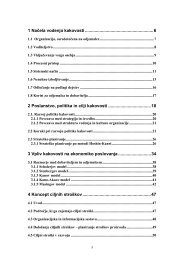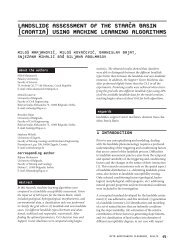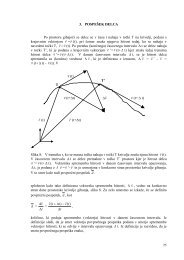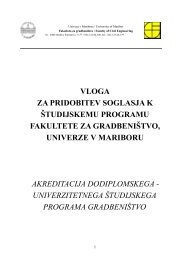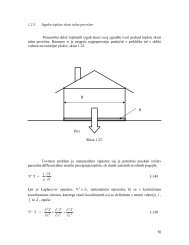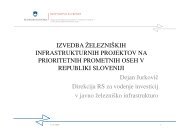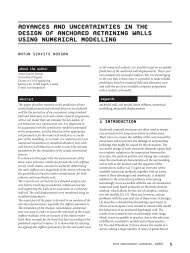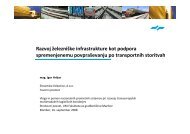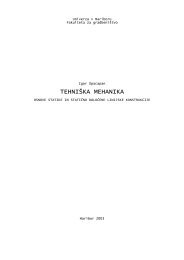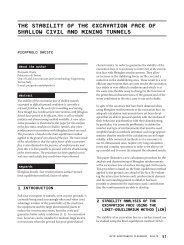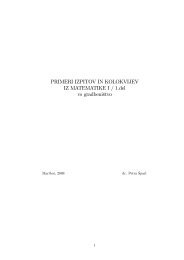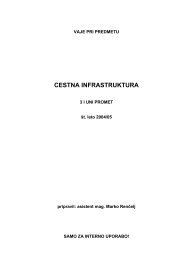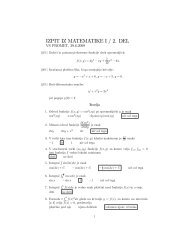Traffic safety analysis of powered two-wheelers (PTWs) in Slovenia
Traffic safety analysis of powered two-wheelers (PTWs) in Slovenia
Traffic safety analysis of powered two-wheelers (PTWs) in Slovenia
You also want an ePaper? Increase the reach of your titles
YUMPU automatically turns print PDFs into web optimized ePapers that Google loves.
G Model<br />
AAP-2649; No. <strong>of</strong> Pages 8<br />
ARTICLE IN PRESS<br />
Accident Analysis and Prevention xxx (2012) xxx– xxx<br />
Contents lists available at SciVerse ScienceDirect<br />
Accident Analysis and Prevention<br />
j ourna l h o mepage: www.elsevier.com/locate/aap<br />
<strong>Traffic</strong> <strong>safety</strong> <strong>analysis</strong> <strong>of</strong> <strong>powered</strong> <strong>two</strong>-<strong>wheelers</strong> (<strong>PTWs</strong>) <strong>in</strong> <strong>Slovenia</strong><br />
Matjaˇz ˇSraml, Tomaˇz Tollazzi, Marko Renčelj ∗<br />
University <strong>of</strong> Maribor, Faculty for Civil Eng<strong>in</strong>eer<strong>in</strong>g, Smetanova 17, 2000 Maribor, <strong>Slovenia</strong><br />
a r t i c l e i n f o<br />
Article history:<br />
Received 30 July 2010<br />
Received <strong>in</strong> revised form<br />
22 November 2011<br />
Accepted 31 December 2011<br />
Keywords:<br />
Powered <strong>two</strong>-<strong>wheelers</strong> (<strong>PTWs</strong>)<br />
Dangerous sections<br />
Safety <strong>of</strong> PTW riders <strong>in</strong> <strong>Slovenia</strong><br />
1. Introduction<br />
a b s t r a c t<br />
Riders <strong>of</strong> <strong>powered</strong> <strong>two</strong>-<strong>wheelers</strong> (<strong>PTWs</strong>) <strong>in</strong> the European Union<br />
(EU) are generally one <strong>of</strong> the most vulnerable groups <strong>of</strong> road users.<br />
What particularly concerns is the fact that the degree <strong>of</strong> difficulty<br />
<strong>of</strong> traffic accidents <strong>in</strong>volv<strong>in</strong>g PTW riders is very high. Risk <strong>of</strong> traffic<br />
accident fatalities for PTW riders is 18 times higher than for the<br />
car drivers. Royal Society for the Prevention <strong>of</strong> Accidents (2010)<br />
reports that the level <strong>of</strong> traffic <strong>safety</strong> risk rises with the age <strong>of</strong> PTW<br />
riders. Until 1996, PTW riders accounted for 9.5% <strong>of</strong> all road accident<br />
fatalities <strong>in</strong> 2006, 6200 PTW riders died <strong>in</strong> traffic accidents <strong>in</strong><br />
the EU, what already represents 16% <strong>of</strong> all road accident fatalities.<br />
On the other hand, PTW riders travelled only 2% <strong>of</strong> total travelled<br />
kilometers (ETSC, 2007).<br />
There are 27 million mopeds and motorcycles with an eng<strong>in</strong>e<br />
<strong>of</strong> 50 cc or more registered <strong>in</strong> the countries <strong>of</strong> the EU (FEMA,<br />
2007). Over the last five years a significant <strong>in</strong>crease <strong>in</strong> the number<br />
<strong>of</strong> vehicles by 41% was recorded, while <strong>in</strong> the last 20 years<br />
the number was doubled. Travelled kilometers <strong>of</strong> different types<br />
<strong>of</strong> road vehicles for the last decade <strong>in</strong> the EU countries show a disproportionate<br />
<strong>in</strong>crease <strong>of</strong> the number <strong>of</strong> kilometers travelled by<br />
<strong>PTWs</strong> for 49%, while for the other types <strong>of</strong> vehicles the <strong>in</strong>crease is<br />
only 15%, which highlights the <strong>in</strong>creas<strong>in</strong>g use <strong>of</strong> motorcycles not<br />
only <strong>in</strong> urban areas but also <strong>in</strong> road traffic (ETSC, 2008b). Indeed,<br />
<strong>in</strong>creased use <strong>of</strong> motorbikes and scooters is a result <strong>of</strong> some advantages<br />
that this type <strong>of</strong> <strong>in</strong>-service provides: less need for surface<br />
∗ Correspond<strong>in</strong>g author. Tel.: +386 22294372; fax: +386 22524179.<br />
E-mail addresses: sraml.matjaz@uni-mb.si (M. ˇSraml), tomaz.tollazzi@uni-mb.si<br />
(T. Tollazzi), marko.rencelj@uni-mb.si (M. Renčelj).<br />
0001-4575/$ – see front matter ©<br />
2012 Elsevier Ltd. All rights reserved.<br />
doi:10.1016/j.aap.2011.12.013<br />
Due to the 2006 European research report on <strong>powered</strong> <strong>two</strong>-<strong>wheelers</strong> (<strong>PTWs</strong>) riders’ traffic <strong>safety</strong>, <strong>Slovenia</strong><br />
represents the highest risk for PTW riders <strong>in</strong> the European Union. Namely, <strong>in</strong> <strong>Slovenia</strong> we have the<br />
largest number <strong>of</strong> PTW riders’ deaths per billion travelled kilometers <strong>in</strong> 2006. S<strong>in</strong>ce then the traffic <strong>safety</strong><br />
situation <strong>in</strong> the field <strong>of</strong> PTW riders <strong>in</strong> <strong>Slovenia</strong> has been improv<strong>in</strong>g and we will discuss that phenomenon<br />
<strong>in</strong> the present paper.<br />
The paper identifies and analyzes the causes that led to such a critical situation. Further, the evaluation<br />
<strong>of</strong> activities that were carried out to improve the road <strong>safety</strong> for <strong>powered</strong> <strong>two</strong>-wheeler riders <strong>in</strong> <strong>Slovenia</strong><br />
<strong>in</strong> the last past years are discussed. In conclusion a selection <strong>of</strong> measures and actions is presented that<br />
already has been and also should be carried out <strong>in</strong> the future.<br />
© 2012 Elsevier Ltd. All rights reserved.<br />
transport <strong>in</strong>frastructure, less traffic jams (the <strong>PTWs</strong> <strong>in</strong> comparison<br />
with other vehicles dur<strong>in</strong>g peak traffic congestion require<br />
16–48% less time to transport the same way), reduced fuel consumption<br />
(compared with other vehicles the fuel consumption for<br />
the same route is 55–81% lower), less space required for park<strong>in</strong>g,<br />
etc.<br />
<strong>PTWs</strong> are generally dynamical unstable vehicles, therefore the<br />
possibility for an accident is higher than that with other vehicles on<br />
the road. However, the <strong>in</strong>fluence <strong>of</strong> PTW riders is also very important,<br />
especially their psycho-physical capabilities. Lately, a lot <strong>of</strong><br />
effort has been done concern<strong>in</strong>g higher road <strong>safety</strong> <strong>of</strong> PTW riders<br />
<strong>in</strong> the EU. The EU f<strong>in</strong>anced several projects, e.g. <strong>in</strong>vestigation <strong>of</strong><br />
accidentology (MAIDS, RIDER, etc.), improvement <strong>of</strong> passive <strong>safety</strong><br />
(APROSYS SP4), understand<strong>in</strong>g the sociology <strong>of</strong> riders (MAIDS, 2-<br />
BE-SAFE, etc.), advanced telematics for enhanc<strong>in</strong>g the <strong>safety</strong> and<br />
comfort <strong>of</strong> motorcycle riders (SAFERIDER). There are also some<br />
papers, e.g. <strong>of</strong>ficial document on “Road <strong>safety</strong> as a right and responsibility<br />
for all” – a bluepr<strong>in</strong>t for the EU’s 4th Road Safety Action<br />
Program 2010–2020 (ETSC, 2008a), and projects about road <strong>in</strong>frastructure<br />
<strong>safety</strong> <strong>of</strong> <strong>PTWs</strong>, e.g. RANKERS, RISER, GINA, Guidel<strong>in</strong>es to<br />
Black Spot Management.<br />
Accord<strong>in</strong>g to the report (ETSC, 2007) on “Road <strong>safety</strong> performance<br />
<strong>in</strong>dex”, that ranked the <strong>safety</strong> <strong>of</strong> PTW riders <strong>in</strong> Europe,<br />
<strong>Slovenia</strong> “won” the first place: we have the largest number <strong>of</strong> PTW<br />
riders deaths per billion travelled kilometers <strong>in</strong> 2006 (more than<br />
350, while the EU average was 86). Another very concern<strong>in</strong>g fact is<br />
that we have the highest ratio <strong>of</strong> death rate per billion kilometers<br />
ridden by PTW riders to correspond<strong>in</strong>g rate for car drivers <strong>in</strong> 2006<br />
(ETSC, 2007) (more than 50, EU average 18). These <strong>two</strong> facts <strong>in</strong>dicate<br />
that “PTW problem” <strong>in</strong> <strong>Slovenia</strong> needs to be discussed, well<br />
studied, and carefully treated.<br />
Please cite this article <strong>in</strong> press as: ˇSraml, M., et al., <strong>Traffic</strong> <strong>safety</strong> <strong>analysis</strong> <strong>of</strong> <strong>powered</strong> <strong>two</strong>-<strong>wheelers</strong> (<strong>PTWs</strong>) <strong>in</strong> <strong>Slovenia</strong>. Accid. Anal. Prev. (2012),<br />
doi:10.1016/j.aap.2011.12.013
ARTICLE IN PRESS<br />
G Model<br />
AAP-2649; No. <strong>of</strong> Pages 8<br />
2 M. ˇSraml et al. / Accident Analysis and Prevention xxx (2012) xxx– xxx<br />
Regard<strong>in</strong>g the development <strong>of</strong> traffic <strong>safety</strong> or road accidents<br />
and its consequences, <strong>Slovenia</strong> is rather unsteady country. There<br />
are <strong>two</strong> ma<strong>in</strong> reasons prov<strong>in</strong>g this fact:<br />
• drastic change <strong>of</strong> number <strong>of</strong> road accidents and their consequences<br />
<strong>in</strong> the last 10 years;<br />
• the so-called migration <strong>of</strong> road accidents with seriously <strong>in</strong>jured<br />
and death casualties – considerable change <strong>in</strong> proportion regard<strong>in</strong>g<br />
the <strong>in</strong>dividual traffic participants.<br />
Statistical results for road accidents <strong>in</strong> <strong>Slovenia</strong> (<strong>in</strong> the period<br />
1970–2010, see Fig. 1) showed that <strong>in</strong> the last 41 years there has<br />
Fig. 1. Number <strong>of</strong> fatalities <strong>in</strong> road traffic <strong>in</strong> <strong>Slovenia</strong> <strong>in</strong> the period 1970–2010.<br />
been 18,805 fatalities, or <strong>in</strong> more detail, 620 fatalities <strong>in</strong> year 1970;<br />
the highest value <strong>of</strong> fatalities was <strong>in</strong> the year 1979 (735) and the<br />
lowest <strong>in</strong> the year 2010 (138). While <strong>in</strong> the analyzed period the<br />
number <strong>of</strong> fatalities – regard<strong>in</strong>g different types <strong>of</strong> road participants<br />
– dim<strong>in</strong>ished and only the number <strong>of</strong> deaths <strong>of</strong> PTW riders<br />
rema<strong>in</strong>ed stable throughout the period – with a significant <strong>in</strong>crease<br />
<strong>in</strong> the last 10 years (from year 2000 to 2010): the average number <strong>of</strong><br />
fatalities <strong>of</strong> PTW riders <strong>in</strong> the period 1970–2000 was 20.3 per year,<br />
while <strong>in</strong> the period 2000–2010 nearly every year the number <strong>of</strong><br />
deaths <strong>of</strong> PTW riders was higher than the average value. Moreover,<br />
at almost 50% reduction <strong>of</strong> all fatalities (<strong>in</strong> road accidents) <strong>in</strong> the<br />
period 2002–2010 (see Fig. 2), the number <strong>of</strong> fatalities concern<strong>in</strong>g<br />
Fig. 2. Number <strong>of</strong> all fatalities and PTW’s fatalities <strong>in</strong> the period 2002–2010, <strong>in</strong>dex value regard<strong>in</strong>g year 2002.<br />
Please cite this article <strong>in</strong> press as: ˇSraml, M., et al., <strong>Traffic</strong> <strong>safety</strong> <strong>analysis</strong> <strong>of</strong> <strong>powered</strong> <strong>two</strong>-<strong>wheelers</strong> (<strong>PTWs</strong>) <strong>in</strong> <strong>Slovenia</strong>. Accid. Anal. Prev. (2012),<br />
doi:10.1016/j.aap.2011.12.013
G Model<br />
AAP-2649; No. <strong>of</strong> Pages 8<br />
PTW riders <strong>in</strong>creased (<strong>in</strong>dex 100 for the year 2002) till year 2006.<br />
This is what should worry <strong>Slovenia</strong>n experts deal<strong>in</strong>g with traffic<br />
<strong>safety</strong>, particularly with the <strong>safety</strong> <strong>of</strong> PTW riders.<br />
In the year 1970 PTW riders were among all participants <strong>in</strong><br />
road accidents at the lowest level <strong>of</strong> fatalities, with only 9.68% <strong>of</strong><br />
all fatalities <strong>in</strong> road accidents (36.13% pedestrians, 22.58% passengers,<br />
17.42% passenger vehicle drivers, 11.13% cyclists, 9.68% PTW<br />
riders, and 3.06% other participants <strong>in</strong> road accidents). While the<br />
situation <strong>in</strong> year 2010 was completely different: PTW riders were<br />
equivalent to 16.7% <strong>of</strong> all fatalities <strong>in</strong> road accidents, they were <strong>in</strong><br />
the third place after drivers and passengers <strong>of</strong> personal vehicles<br />
(18.84% pedestrians, 15.94% passengers, 32.61% personal vehicle<br />
drivers, 11.59% cyclists, 16.7% PTW riders, and 4.35% other participants<br />
<strong>in</strong> road accidents). Between years 2002 and 2010 (see Fig. 3)<br />
the proportion <strong>of</strong> PTW riders fatalities that died <strong>in</strong> traffic accidents<br />
<strong>in</strong>creased from 8.5% to 16.7% (with the highest number <strong>of</strong> 21.5% <strong>in</strong><br />
year 2008) – which was an emergency situation.<br />
2. Causes for critical traffic <strong>safety</strong> situation <strong>of</strong> PTW riders <strong>in</strong><br />
<strong>Slovenia</strong><br />
A road <strong>safety</strong> problem with PTW riders <strong>in</strong> <strong>Slovenia</strong> became<br />
prom<strong>in</strong>ent after year 2002. S<strong>in</strong>ce then we have recorded a significant<br />
<strong>in</strong>crease <strong>in</strong> the number <strong>of</strong> traffic accidents with the <strong>in</strong>volv<strong>in</strong>g<br />
<strong>PTWs</strong>: the number <strong>of</strong> fatalities <strong>of</strong> <strong>PTWs</strong> is, almost every year, substantially<br />
above the long-term average.<br />
In order to establish causes that brought us to such a critical<br />
situation <strong>in</strong> the field <strong>of</strong> road <strong>safety</strong> <strong>of</strong> PTW riders the M<strong>in</strong>istry <strong>of</strong><br />
Transport <strong>of</strong> Republic <strong>of</strong> <strong>Slovenia</strong> made a call for a research project.<br />
The objective <strong>of</strong> this project was to establish the causes for low<br />
level <strong>of</strong> road <strong>safety</strong> <strong>of</strong> PTW riders, evaluate the effects <strong>of</strong> already<br />
taken measures and suggest further measures. In this paper we<br />
expose ma<strong>in</strong> f<strong>in</strong>d<strong>in</strong>gs <strong>of</strong> this research project which our research<br />
group completed <strong>in</strong> 2010 at the University <strong>of</strong> Maribor, Faculty <strong>of</strong><br />
Civil Eng<strong>in</strong>eer<strong>in</strong>g (Tollazzi et al., 2010).<br />
In order to f<strong>in</strong>d real causes <strong>of</strong> accidents <strong>of</strong> PTW riders on public<br />
roads <strong>in</strong> <strong>Slovenia</strong> we derived from the cybernetic system “the driver<br />
– the vehicle and the environment (roads)”. In our research we<br />
established the follow<strong>in</strong>g causes which have a significant <strong>in</strong>fluence<br />
on bad traffic <strong>safety</strong> <strong>of</strong> PTW riders on <strong>Slovenia</strong>n roads:<br />
ARTICLE IN PRESS<br />
M. ˇSraml et al. / Accident Analysis and Prevention xxx (2012) xxx– xxx 3<br />
Fig. 3. Proportion <strong>of</strong> PTW riders fatalities <strong>in</strong> the period 2002–2010.<br />
• number <strong>of</strong> registered <strong>PTWs</strong>;<br />
• travelled kilometers per year;<br />
• age <strong>of</strong> PTW riders <strong>in</strong>volved <strong>in</strong> traffic accidents;<br />
• dangerous road sections.<br />
2.1. Number <strong>of</strong> registered <strong>PTWs</strong><br />
The diagram on Fig. 4 shows that (<strong>in</strong> <strong>Slovenia</strong>) from year 2002<br />
the number <strong>of</strong> registered passenger cars <strong>in</strong>creased by 18.7% while<br />
dur<strong>in</strong>g the same period the number <strong>of</strong> registered <strong>PTWs</strong> <strong>in</strong>creased<br />
by value <strong>of</strong> 79.8%. Moreover, number <strong>of</strong> registered L3 vehicles<br />
(accord<strong>in</strong>g to MAIDS L1 represent mopeds and m<strong>of</strong>as while L3 represent<br />
motorcycles) <strong>in</strong>creased <strong>in</strong> the same period by four times.<br />
That means an <strong>in</strong>crease <strong>in</strong> the proportion <strong>of</strong> registered <strong>PTWs</strong> with<br />
respect to all registered motor vehicles from 5.04% <strong>in</strong> the year 2002<br />
to 6.78% <strong>in</strong> the year 2010.<br />
Other road participants (drivers <strong>of</strong> personal vehicles, bus<br />
drivers, as well as cyclists and pedestrians) did not expect such<br />
a drastic <strong>in</strong>crease <strong>of</strong> number <strong>of</strong> registered <strong>PTWs</strong> on <strong>Slovenia</strong>n roads<br />
and consequently did not pay enough attention to PTW riders as<br />
equal road participants. All this can cause problems and road accidents<br />
can occur due to the overlooked PTW riders, misjudged riders’<br />
speed, etc.<br />
2.2. Travelled kilometers per year<br />
Because <strong>of</strong> the <strong>in</strong>creased number <strong>of</strong> registered <strong>PTWs</strong> the number<br />
<strong>of</strong> travelled kilometers <strong>of</strong> <strong>PTWs</strong> has also risen. A substantial <strong>in</strong>crease<br />
<strong>of</strong> travelled kilometers per year on the national road ne<strong>two</strong>rk dur<strong>in</strong>g<br />
the last decade has been noticed (see Fig. 5). For passenger cars<br />
there has been an <strong>in</strong>crease <strong>of</strong> travelled kilometers from year 2002<br />
to 2010 – on the national road ne<strong>two</strong>rk – for 23.2%. The value <strong>of</strong><br />
travelled kilometers <strong>of</strong> PTW users is much higher – it has more<br />
than doubled <strong>in</strong> period 2002–2010.<br />
2.3. Age <strong>of</strong> PTW riders <strong>in</strong>volved <strong>in</strong> traffic accidents<br />
Analysis for the period 2005–2008 (see Fig. 6) shows that <strong>in</strong> most<br />
accidents <strong>in</strong>volv<strong>in</strong>g PTW riders the drivers are aged <strong>in</strong> the range <strong>of</strong><br />
18–44, with a significant emphasis from the age group <strong>of</strong> 24–34.<br />
Please cite this article <strong>in</strong> press as: ˇSraml, M., et al., <strong>Traffic</strong> <strong>safety</strong> <strong>analysis</strong> <strong>of</strong> <strong>powered</strong> <strong>two</strong>-<strong>wheelers</strong> (<strong>PTWs</strong>) <strong>in</strong> <strong>Slovenia</strong>. Accid. Anal. Prev. (2012),<br />
doi:10.1016/j.aap.2011.12.013
ARTICLE IN PRESS<br />
G Model<br />
AAP-2649; No. <strong>of</strong> Pages 8<br />
4 M. ˇSraml et al. / Accident Analysis and Prevention xxx (2012) xxx– xxx<br />
2.4. Dangerous and potentially dangerous road sections<br />
Fig. 4. Number <strong>of</strong> registered motor vehicles <strong>in</strong> the period 2002–2010, <strong>in</strong>dex value regard<strong>in</strong>g year 2002.<br />
With<strong>in</strong> the already mentioned research project (Tollazzi<br />
et al., 2010) we also try to f<strong>in</strong>d roads/road sections on state<br />
roads <strong>in</strong> <strong>Slovenia</strong>, which could be (somehow) unsafe for PTW<br />
riders.<br />
In the context <strong>of</strong> determ<strong>in</strong><strong>in</strong>g these road sections we started<br />
from <strong>two</strong> ma<strong>in</strong> orig<strong>in</strong>s: (i) first we tried to f<strong>in</strong>d road sections with<br />
higher number <strong>of</strong> PTW accidents (than on comparable ones) and<br />
secondly (ii) to discover potentially dangerous road sections (road<br />
sections with higher portion <strong>of</strong> <strong>PTWs</strong> than on comparable ones).<br />
For these analyses we used already available data, that is data about<br />
traffic system and PTW traffic <strong>in</strong> <strong>Slovenia</strong> (source: <strong>Slovenia</strong>n Road<br />
Agency) and data about PTW accidents (source: statistical database,<br />
M<strong>in</strong>istry <strong>of</strong> the Interior, Police).<br />
Divid<strong>in</strong>g the unsafe sections on <strong>two</strong> ma<strong>in</strong> categories (dangerous<br />
and potentially dangerous road sections) is also mean<strong>in</strong>gful<br />
<strong>in</strong> terms <strong>of</strong> road management: <strong>in</strong> these sections where the number<br />
<strong>of</strong> traffic accidents with PTW drivers <strong>in</strong>volved is higher than<br />
that <strong>in</strong> other comparable segments, it is reasonable to th<strong>in</strong>k about<br />
short-term (immediate) actions.<br />
On road sections which were identified as potentially dangerous<br />
it is reasonable to th<strong>in</strong>k <strong>of</strong> preventive action, e.g. <strong>in</strong>stallation <strong>of</strong><br />
traffic signs and signals to <strong>in</strong>form participants on the road section<br />
that a larger number <strong>of</strong> PTW drivers are present <strong>in</strong> the structure <strong>of</strong><br />
traffic flow.<br />
2.4.1. Identification <strong>of</strong> dangerous road sections<br />
When search<strong>in</strong>g for reasons for low level <strong>of</strong> traffic <strong>safety</strong> <strong>of</strong> PTW<br />
riders <strong>in</strong> <strong>Slovenia</strong>, one <strong>of</strong> our ma<strong>in</strong> goals was to f<strong>in</strong>d <strong>in</strong>frastructure<br />
Fig. 5. Travelled kilometers (passenger cars, <strong>PTWs</strong>) <strong>in</strong> the period 2002–2009, <strong>in</strong>dex value regard<strong>in</strong>g year 2002.<br />
Please cite this article <strong>in</strong> press as: ˇSraml, M., et al., <strong>Traffic</strong> <strong>safety</strong> <strong>analysis</strong> <strong>of</strong> <strong>powered</strong> <strong>two</strong>-<strong>wheelers</strong> (<strong>PTWs</strong>) <strong>in</strong> <strong>Slovenia</strong>. Accid. Anal. Prev. (2012),<br />
doi:10.1016/j.aap.2011.12.013
G Model<br />
AAP-2649; No. <strong>of</strong> Pages 8<br />
ARTICLE IN PRESS<br />
M. ˇSraml et al. / Accident Analysis and Prevention xxx (2012) xxx– xxx 5<br />
Fig. 6. Age classes <strong>of</strong> PTW riders <strong>in</strong>volved <strong>in</strong> traffic accidents (separately for different type <strong>of</strong> accidents), summarized for the period 2005–2008.<br />
related causes. Accord<strong>in</strong>g to that we (i) determ<strong>in</strong>ed the location<br />
on state roads <strong>in</strong> <strong>Slovenia</strong> with high concentration <strong>of</strong> PTW riders<br />
traffic accidents, (ii) exposed causes for these accidents, and (iii)<br />
recommended measures for the elim<strong>in</strong>ation <strong>of</strong> the causes <strong>of</strong> accidents<br />
aris<strong>in</strong>g from the road <strong>in</strong>frastructure (design, construction,<br />
and ma<strong>in</strong>tenance).<br />
As a road section with high concentration <strong>of</strong> PTW riders traffic<br />
accidents <strong>in</strong> our research project (Tollazzi et al., 2010) we def<strong>in</strong>ed<br />
a road segment where more traffic accidents with PTW riders have<br />
occurred over certa<strong>in</strong> period <strong>of</strong> time as <strong>in</strong> other comparable road<br />
sections. For these analyses we used the so-called slid<strong>in</strong>g w<strong>in</strong>dow<br />
method (Elvik, 2008). In our case it was appropriate to use w<strong>in</strong>dow<br />
<strong>of</strong> fixed length (1.0 km) which was moved forward one step<br />
at a time (each step correspond<strong>in</strong>g to the length <strong>of</strong> 100 m). As a<br />
result <strong>of</strong> the performed analyses we obta<strong>in</strong>ed the most critical sections<br />
on the national road ne<strong>two</strong>rk <strong>in</strong> <strong>Slovenia</strong> where over the<br />
period 2003–2008 traffic accidents condensation <strong>in</strong>volv<strong>in</strong>g PTW<br />
riders occurred.<br />
The <strong>analysis</strong> showed that <strong>in</strong> the period 2003–2008 <strong>two</strong> road<br />
sections (length <strong>of</strong> 1 km) stood out, namely the sections where 33<br />
and 23 traffic accidents with PTW riders <strong>in</strong>volved occurred. On the<br />
other analyzed road sections there were 10 (and less) accidents<br />
with PTW riders <strong>in</strong>volved <strong>in</strong> the same period <strong>of</strong> time. These <strong>two</strong> road<br />
sections represent regional roads with low traffic volume (AADT<br />
less than 2000 vehicles per day), settled <strong>in</strong> the hilly terra<strong>in</strong> (curved<br />
road alignment, small radius <strong>of</strong> horizontal curves, etc.). Subsequent<br />
<strong>analysis</strong> showed that these (and similar) road sections are used by<br />
PTW riders <strong>in</strong> <strong>Slovenia</strong> to exploit the wanton driv<strong>in</strong>g and test<strong>in</strong>g<br />
driv<strong>in</strong>g capabilities (driv<strong>in</strong>g fast through curves, etc.).<br />
2.4.2. Identification <strong>of</strong> potentially dangerous road sections<br />
In order to f<strong>in</strong>d potentially dangerous sections <strong>of</strong> national roads<br />
we performed the identification <strong>of</strong> these segments where number<br />
and/or proportion <strong>of</strong> <strong>PTWs</strong> <strong>in</strong> traffic flow is the highest (Tollazzi<br />
et al., 2010).<br />
As a basis for this identification <strong>of</strong> potentially dangerous sections<br />
<strong>in</strong> the national road ne<strong>two</strong>rk <strong>in</strong> <strong>Slovenia</strong> we analyzed database<br />
about motorized traffic on the national road ne<strong>two</strong>rk <strong>in</strong> 2007 (DRSC,<br />
2010).<br />
Identification <strong>of</strong> potentially dangerous road sections was performed<br />
on the basis <strong>of</strong> <strong>two</strong> criteria: (i) the absolute number <strong>of</strong> <strong>PTWs</strong><br />
<strong>in</strong> the traffic flow and (ii) the proportion <strong>of</strong> <strong>PTWs</strong> <strong>in</strong> the traffic flow.<br />
The results <strong>of</strong> the <strong>analysis</strong> showed that the largest share <strong>of</strong> <strong>PTWs</strong><br />
<strong>in</strong> the traffic flow occur at low-volume tourist recreational roads.<br />
Share <strong>of</strong> <strong>PTWs</strong> on these roads is relatively high: the top 10 road<br />
sections have share <strong>of</strong> <strong>PTWs</strong> from 6.8 to 71.8%. Additionally, AADT<br />
on these roads are below 1000 vehicles per day. Furthermore, it<br />
has to be po<strong>in</strong>ted out that traffic accidents on these sections are<br />
relatively rare.<br />
2.5. Summary <strong>of</strong> f<strong>in</strong>d<strong>in</strong>gs<br />
Based on the data <strong>analysis</strong> <strong>of</strong> traffic accidents with PTW riders<br />
on <strong>Slovenia</strong>n roads <strong>in</strong> the period 2006–2008 (Tollazzi et al., 2010)<br />
the follow<strong>in</strong>g key f<strong>in</strong>d<strong>in</strong>gs may be po<strong>in</strong>ted out:<br />
• for PTW riders <strong>in</strong> <strong>Slovenia</strong> the risk <strong>of</strong> be<strong>in</strong>g killed <strong>in</strong> a traffic crash<br />
is 40 times higher than that for a car occupant;<br />
• although <strong>in</strong> all traffic accidents with <strong>in</strong>jured participants PTW<br />
riders were <strong>in</strong>volved <strong>in</strong> only 6.5% <strong>of</strong> these accidents, accidents<br />
with PTW participants resulted <strong>in</strong> 71% <strong>of</strong> all <strong>in</strong>juries;<br />
• proportion <strong>of</strong> fatalities <strong>of</strong> PTW riders (compared with all fatalities<br />
<strong>in</strong> traffic accidents) <strong>in</strong> urban areas is 13% and outside these areas<br />
26%;<br />
• accidents where PTW riders were <strong>in</strong>volved ma<strong>in</strong>ly occur on the<br />
ma<strong>in</strong> and regional state roads and <strong>in</strong> urban areas with street<br />
system;<br />
• among accidents <strong>of</strong> PTW riders there is almost 43% <strong>of</strong> the socalled<br />
<strong>in</strong>dividual (solo) PTW riders accident <strong>in</strong> which no other<br />
vehicles are <strong>in</strong>volved; collisions <strong>of</strong> PTW riders with passenger<br />
cars represent 29% <strong>of</strong> PTW riders’ accidents;<br />
• <strong>in</strong> accidents where PTW riders were <strong>in</strong>volved there were 62%<br />
accidents with PTW riders caus<strong>in</strong>g the traffic accidents;<br />
• most <strong>of</strong> the accidents (92%) <strong>in</strong>volv<strong>in</strong>g PTW riders occurred on the<br />
so-called “open roads” (road sections), on dry road surface; ma<strong>in</strong><br />
cause <strong>of</strong> accidents is unadjusted speed (53%);<br />
• PTW riders were equipped with helmets <strong>in</strong> most traffic accidents;<br />
• typical for accidents with PTW riders <strong>in</strong>volved is that <strong>in</strong> most<br />
cases the riders hold their driv<strong>in</strong>g license for less than 3 years.<br />
Please cite this article <strong>in</strong> press as: ˇSraml, M., et al., <strong>Traffic</strong> <strong>safety</strong> <strong>analysis</strong> <strong>of</strong> <strong>powered</strong> <strong>two</strong>-<strong>wheelers</strong> (<strong>PTWs</strong>) <strong>in</strong> <strong>Slovenia</strong>. Accid. Anal. Prev. (2012),<br />
doi:10.1016/j.aap.2011.12.013
ARTICLE IN PRESS<br />
G Model<br />
AAP-2649; No. <strong>of</strong> Pages 8<br />
6 M. ˇSraml et al. / Accident Analysis and Prevention xxx (2012) xxx– xxx<br />
3. Activities for improv<strong>in</strong>g traffic <strong>safety</strong> <strong>of</strong> PTW riders <strong>in</strong><br />
<strong>Slovenia</strong><br />
As po<strong>in</strong>ted out <strong>in</strong> Section 1, critical traffic <strong>safety</strong> <strong>of</strong> PTW riders <strong>in</strong><br />
<strong>Slovenia</strong> revealed an alarm<strong>in</strong>g situation that requires appropriate<br />
and immediate actions. Improved traffic <strong>safety</strong> situation <strong>of</strong> PTW<br />
riders <strong>in</strong> <strong>Slovenia</strong>, as reflected from the recent years (see Fig. 2), is<br />
mostly attributable to the measures implemented by:<br />
• the National Road Safety Program (NRSP), time period<br />
2007–2011;<br />
• the M<strong>in</strong>istry <strong>of</strong> the Interior Affairs (Police);<br />
• the <strong>Slovenia</strong>n Road Agency.<br />
3.1. The National Road Safety Program for the period 2007–2011<br />
The NRSP pays additional attention also to traffic <strong>safety</strong> <strong>of</strong> PTW<br />
riders <strong>in</strong> <strong>Slovenia</strong>. To improve the traffic <strong>safety</strong> the follow<strong>in</strong>g activities<br />
were def<strong>in</strong>ed:<br />
• implementation <strong>of</strong> programs for novice drivers (also for PTW riders),<br />
e.g. practice <strong>of</strong> safe driv<strong>in</strong>g, workshops about traffic <strong>safety</strong>,<br />
teach<strong>in</strong>g about psycho-social relations between participants <strong>in</strong><br />
road traffic, etc.;<br />
• organiz<strong>in</strong>g workshops (or other forms) to pass on experiences<br />
about safe driv<strong>in</strong>g, promotion <strong>of</strong> strategies for safer driv<strong>in</strong>g (experiences<br />
as advice, workshops at motorcycle clubs, etc.);<br />
• implementation <strong>of</strong> monitor<strong>in</strong>g program for novice drivers (additional<br />
obligations after the f<strong>in</strong>al exam);<br />
• control over the use <strong>of</strong> <strong>safety</strong> helmets;<br />
• control at locations where accidents with PTW riders <strong>in</strong>volved<br />
are frequent;<br />
• promotion <strong>of</strong> the <strong>in</strong>tegration <strong>of</strong> PTW riders <strong>in</strong> motorcycle clubs.<br />
3.2. Measures <strong>of</strong> the <strong>Slovenia</strong>n M<strong>in</strong>istry <strong>of</strong> the Interior Affairs<br />
(Police)<br />
<strong>Slovenia</strong>n Police is, accord<strong>in</strong>g to the National Road Safety Program<br />
(2007–2011), actively <strong>in</strong>volved <strong>in</strong> the implementation <strong>of</strong> PTW<br />
<strong>safety</strong> improvement. The follow<strong>in</strong>g activities were def<strong>in</strong>ed:<br />
• systematic control over participants <strong>in</strong> road traffic who frequently<br />
break the road traffic regulations;<br />
• police presence at critical road sections, and <strong>in</strong> critical periods <strong>of</strong><br />
time (particularly regard<strong>in</strong>g the time <strong>of</strong> seasons), where traffic<br />
accidents with PTW riders <strong>in</strong>volved were the most frequent;<br />
• traffic control with helicopter and additional video-surveillance<br />
system;<br />
• more <strong>in</strong>tense traffic controls <strong>in</strong> cities and settlements;<br />
• co-organization <strong>of</strong> workshops, etc.<br />
3.3. Measures <strong>of</strong> the <strong>Slovenia</strong>n Road Agency<br />
<strong>Slovenia</strong>n Road Agency is also actively <strong>in</strong>volved <strong>in</strong> implement<strong>in</strong>g<br />
measures to improve traffic <strong>safety</strong> for PTW riders. The measures<br />
are primarily orientated to ensure safe road <strong>in</strong>frastructure for PTW<br />
riders. Implemented measures <strong>in</strong>clude:<br />
• <strong>in</strong>stallation <strong>of</strong> additional security elements for <strong>PTWs</strong> (see Fig. 8)<br />
on exist<strong>in</strong>g guardrails (<strong>in</strong> the period from 2005 to 2010 implemented<br />
at total length <strong>of</strong> 16.1 km);<br />
• <strong>in</strong>stallation <strong>of</strong> traffic signs which warn PTW riders on a dangerous<br />
road section (<strong>in</strong> the period from 2005 to 2010 there were 62 signs<br />
<strong>in</strong>stalled);<br />
• <strong>in</strong>stallation <strong>of</strong> traffic signs which warn drivers on “black spot”<br />
location (<strong>in</strong> 2010 there were five signs <strong>in</strong>stalled);<br />
• <strong>in</strong>stallation <strong>of</strong> permanent (fixed) speed cameras (<strong>two</strong> <strong>of</strong> them<br />
were <strong>in</strong>stalled <strong>in</strong> 2010);<br />
• test<strong>in</strong>g <strong>in</strong>stallation <strong>of</strong> additional road mark<strong>in</strong>gs on critical road<br />
sections (additional warn<strong>in</strong>g for PTW riders, sign for speed limit,<br />
etc.);<br />
• realization <strong>of</strong> a research project “Measures to improve traffic<br />
<strong>safety</strong> <strong>of</strong> PTW riders <strong>in</strong> <strong>Slovenia</strong>” (Tollazzi et al., 2010); the project<br />
aimed to identify causes for critical traffic <strong>safety</strong> <strong>of</strong> PTW riders<br />
and for potential locations with congestion <strong>of</strong> traffic accidents<br />
<strong>in</strong>volv<strong>in</strong>g PTW riders on the national road ne<strong>two</strong>rk; the project<br />
also proposed measures for improv<strong>in</strong>g traffic <strong>safety</strong> <strong>of</strong> PTW riders<br />
<strong>in</strong> <strong>Slovenia</strong>.<br />
We have to po<strong>in</strong>t out that there are also some other activities<br />
that support improvement <strong>of</strong> traffic <strong>safety</strong> <strong>of</strong> PTW riders <strong>in</strong><br />
<strong>Slovenia</strong>, for example civil associations campaigns, medias (various<br />
publications, brochures, <strong>in</strong>formation on the <strong>in</strong>ternet, etc.).<br />
4. Proposal <strong>of</strong> further actions to improve traffic <strong>safety</strong> <strong>of</strong><br />
PTW riders <strong>in</strong> <strong>Slovenia</strong><br />
Some road <strong>safety</strong> problems have persisted for a long time <strong>in</strong><br />
nearly all motorized countries, suggest<strong>in</strong>g that they are not easily<br />
solved (Elvik, 2010). The current situation <strong>in</strong> the field <strong>of</strong> road <strong>safety</strong><br />
<strong>in</strong> <strong>Slovenia</strong> is – despite the highly ambitious plans – still not satisfactory.<br />
It has to be admitted that traffic <strong>safety</strong> <strong>in</strong> <strong>Slovenia</strong> has been<br />
improved dur<strong>in</strong>g the last few years but we still have not achieved<br />
the objectives <strong>of</strong> reduc<strong>in</strong>g road accidents, <strong>in</strong>jured participants, or<br />
dead casualties – also with<strong>in</strong> PTW riders.<br />
Accord<strong>in</strong>g to the ma<strong>in</strong> f<strong>in</strong>d<strong>in</strong>gs presented <strong>in</strong> the manuscript<br />
and tak<strong>in</strong>g <strong>in</strong>to account the conclusions <strong>of</strong> the performed research<br />
(Tollazzi et al., 2010) we may therefore re-summarize those ma<strong>in</strong><br />
causes and factors that ma<strong>in</strong>ly contributed to the critical traffic<br />
<strong>safety</strong> <strong>of</strong> PTW riders <strong>in</strong> <strong>Slovenia</strong>:<br />
• from the year 2002 (and especially <strong>in</strong> the last five years) we have<br />
noticed extreme <strong>in</strong>crease <strong>of</strong> the number <strong>of</strong> registered PTW (see<br />
Fig. 4 for details); consequently this results <strong>in</strong> more PTW users<br />
on the roads with some negative effect: other users <strong>in</strong> road traffic<br />
are not yet completely accustomed to adopt/accept PTW riders<br />
on our roads as permanent participants;<br />
• geographical position <strong>of</strong> <strong>Slovenia</strong> <strong>in</strong>dicates reasons for large<br />
amount <strong>of</strong> transit traffic which results <strong>in</strong> several foreign drivers<br />
on <strong>Slovenia</strong>n roads, especially dur<strong>in</strong>g the summer; <strong>in</strong> conjunction<br />
with this fact we should mention different characteristics <strong>of</strong><br />
drivers, e.g. travell<strong>in</strong>g on unknown roads, etc.;<br />
• climatic conditions <strong>in</strong> <strong>Slovenia</strong> limit PTW usage to the period <strong>of</strong><br />
five months (from May to September); consequently the number<br />
<strong>of</strong> travelled kilometers by <strong>PTWs</strong> <strong>in</strong> <strong>Slovenia</strong> is relatively small;<br />
that also means that <strong>PTWs</strong> riders have difficulties to obta<strong>in</strong> necessary<br />
experiences;<br />
• especially young PTW riders are us<strong>in</strong>g <strong>Slovenia</strong>n roads as a rac<strong>in</strong>g<br />
track: the fact is that <strong>in</strong> <strong>Slovenia</strong> there are currently no suitable<br />
rac<strong>in</strong>g tracks for PTW riders (or any others);<br />
• “rac<strong>in</strong>g” <strong>of</strong> PTW riders occurs primarily on the sections that are<br />
identified as attractive for PTW users: sections with low traffic<br />
volume, “wrapped” road with curved road serpent<strong>in</strong>es, etc.;<br />
these road sections were <strong>in</strong> most cases identified as sections with<br />
<strong>in</strong>creased traffic accident condensation, i.e. dangerous sections;<br />
• driv<strong>in</strong>g schools <strong>in</strong> <strong>Slovenia</strong>, <strong>in</strong> most cases, do not posses appropriate<br />
facilities, i.e. driv<strong>in</strong>g polygons where PTW users can – dur<strong>in</strong>g<br />
the process <strong>of</strong> obta<strong>in</strong><strong>in</strong>g a driv<strong>in</strong>g license – test all potentially<br />
Please cite this article <strong>in</strong> press as: ˇSraml, M., et al., <strong>Traffic</strong> <strong>safety</strong> <strong>analysis</strong> <strong>of</strong> <strong>powered</strong> <strong>two</strong>-<strong>wheelers</strong> (<strong>PTWs</strong>) <strong>in</strong> <strong>Slovenia</strong>. Accid. Anal. Prev. (2012),<br />
doi:10.1016/j.aap.2011.12.013
G Model<br />
AAP-2649; No. <strong>of</strong> Pages 8<br />
Fig. 7. Mark<strong>in</strong>g a dangerous road section for PTW riders with additional traffic sign.<br />
dangerous situations and improve their skills <strong>of</strong> rid<strong>in</strong>g <strong>PTWs</strong> after<br />
obta<strong>in</strong><strong>in</strong>g a driv<strong>in</strong>g license;<br />
• follow<strong>in</strong>g the performed <strong>analysis</strong> <strong>of</strong> identify<strong>in</strong>g dangerous road<br />
sections on <strong>Slovenia</strong>n roads we can conclude that no particular<br />
irregularities <strong>of</strong> the road <strong>in</strong>frastructure (the geometric elements<br />
<strong>of</strong> road, cross fall, traffic signalization, and equipment) were identified;<br />
therefore, we can establish that the road <strong>in</strong>frastructure is<br />
not the ma<strong>in</strong> reason for traffic accidents condensation, <strong>in</strong>volv<strong>in</strong>g<br />
PTW riders, on particular dangerous road section.<br />
Present f<strong>in</strong>d<strong>in</strong>gs represent our proposals to improve the exist<strong>in</strong>g<br />
traffic <strong>safety</strong> <strong>of</strong> PTW riders <strong>in</strong> <strong>Slovenia</strong>. Nevertheless, regard<strong>in</strong>g<br />
the results from the <strong>analysis</strong> about PTW riders’ <strong>safety</strong>, we suggest<br />
some additional measures/actions for improv<strong>in</strong>g traffic <strong>safety</strong> situation<br />
<strong>of</strong> PTW riders <strong>in</strong> <strong>Slovenia</strong>. The proposed process has <strong>two</strong> ma<strong>in</strong><br />
directions:<br />
(i) the so-called “immediately actions” (which attempt to calm the<br />
current situation):<br />
• <strong>in</strong>stall<strong>in</strong>g non-traffic signalization at dangerous sections for<br />
additional attention <strong>of</strong> PTW riders;<br />
• the <strong>in</strong>troduction <strong>of</strong> additional def<strong>in</strong>itions <strong>in</strong> the regulations<br />
and legislation relat<strong>in</strong>g to road design <strong>in</strong> order to reduce the<br />
possibility <strong>of</strong> cont<strong>in</strong>ued occurrence <strong>of</strong> traffic accidents with<br />
PTW riders;<br />
Fig. 8. Guardrail with additional protection for PTW riders: schematic sketch.<br />
ARTICLE IN PRESS<br />
M. ˇSraml et al. / Accident Analysis and Prevention xxx (2012) xxx– xxx 7<br />
Fig. 9. Guardrail with additional protection for PTW riders: application on road<br />
section.<br />
(ii) “preventive action” (<strong>in</strong> order to prevent the cont<strong>in</strong>uation <strong>of</strong><br />
current situation <strong>in</strong> the future):<br />
• issue <strong>of</strong> booklets deal<strong>in</strong>g with road <strong>safety</strong> for PTW riders,<br />
<strong>in</strong>tended for all motorized road users;<br />
• <strong>in</strong>troduction <strong>of</strong> additional def<strong>in</strong>itions <strong>in</strong> the regulations and<br />
legislation relat<strong>in</strong>g to road design <strong>in</strong> order to reduce the risk<br />
<strong>of</strong> accidents with PTW riders <strong>in</strong> the future.<br />
At this moment <strong>in</strong>stallation <strong>of</strong> non-traffic signalization for PTW<br />
riders is be<strong>in</strong>g applied to all national roads with dangerous and<br />
potentially dangerous sections to warn all PTW riders about possible<br />
dangerous sections (see Fig. 7). On these sections some fatalities<br />
already occurred <strong>in</strong> the past.<br />
Technical specifications for the security fence sett<strong>in</strong>g (DRSC,<br />
2008) are added to legislation that provide for mandatory <strong>in</strong>stallation<br />
means and methods for <strong>in</strong>stall<strong>in</strong>g additional blades on a steel<br />
security fence on dangerous locations on exist<strong>in</strong>g roads to prevent<br />
serious <strong>in</strong>jury or fatalities <strong>of</strong> PTW riders (see Figs. 8 and 9).<br />
Under the jurisdiction <strong>of</strong> the M<strong>in</strong>istry <strong>of</strong> Transport <strong>of</strong> <strong>Slovenia</strong> a<br />
third brochure has been issued <strong>in</strong> order to improve road <strong>safety</strong> for<br />
PTW riders (DRSC, 2009). The leaflets deal with the strength <strong>of</strong> PTW<br />
riders on road <strong>safety</strong> problem, the dynamics <strong>of</strong> the motorcycle driv<strong>in</strong>g,<br />
brak<strong>in</strong>g distance, brak<strong>in</strong>g process, correct driv<strong>in</strong>g at the time <strong>of</strong><br />
ra<strong>in</strong><strong>in</strong>g, suggestions <strong>of</strong> the police, etc. These brochures also <strong>in</strong>clude<br />
<strong>in</strong>terviews with media personalities that are also PTW drivers.<br />
5. Conclusion<br />
The results <strong>of</strong> the <strong>analysis</strong> <strong>of</strong> statistical data on road <strong>safety</strong> <strong>of</strong><br />
PTW riders for the period 2002–2010, presented <strong>in</strong> this paper, are<br />
alarm<strong>in</strong>g, especially for the period 2002–2006.<br />
Therefore, we have systematically analyzed ma<strong>in</strong> causes for critical<br />
traffic <strong>safety</strong> situation <strong>of</strong> PTW riders <strong>in</strong> <strong>Slovenia</strong>, with ma<strong>in</strong><br />
focus on dangerous road sections. We can summarize the follow<strong>in</strong>g<br />
key f<strong>in</strong>d<strong>in</strong>gs: (i) although PTW riders were <strong>in</strong>volved <strong>in</strong> only<br />
6.5% <strong>of</strong> all traffic accidents with <strong>in</strong>jured participants, accidents with<br />
PTW participants resulted <strong>in</strong> 71% <strong>of</strong> all <strong>in</strong>juries; (ii) proportion <strong>of</strong><br />
fatalities <strong>of</strong> PTW riders (if compared with all fatalities <strong>in</strong> traffic<br />
accidents) is 13% <strong>in</strong> urban areas and 26% outside urban areas; (iii)<br />
among accidents <strong>of</strong> PTW riders there is almost 43% <strong>of</strong> the so-called<br />
<strong>in</strong>dividual (solo) PTW riders accidents <strong>in</strong> which no other vehicles<br />
are <strong>in</strong>volved; (iv) most <strong>of</strong> the accidents (92%) <strong>in</strong>volv<strong>in</strong>g PTW riders<br />
occurred on the so-called “open roads” (road sections), on dry road<br />
surface; ma<strong>in</strong> cause <strong>of</strong> accidents is unadjusted speed (53%).<br />
Follow<strong>in</strong>g these facts, we have implemented different measures<br />
and activities which should improve PTW riders traffic <strong>safety</strong>, e.g.:<br />
(i) implementation <strong>of</strong> programs for novice PTW riders; (ii) organiz<strong>in</strong>g<br />
workshops to pass on experiences about safe driv<strong>in</strong>g and<br />
Please cite this article <strong>in</strong> press as: ˇSraml, M., et al., <strong>Traffic</strong> <strong>safety</strong> <strong>analysis</strong> <strong>of</strong> <strong>powered</strong> <strong>two</strong>-<strong>wheelers</strong> (<strong>PTWs</strong>) <strong>in</strong> <strong>Slovenia</strong>. Accid. Anal. Prev. (2012),<br />
doi:10.1016/j.aap.2011.12.013
ARTICLE IN PRESS<br />
G Model<br />
AAP-2649; No. <strong>of</strong> Pages 8<br />
8 M. ˇSraml et al. / Accident Analysis and Prevention xxx (2012) xxx– xxx<br />
promotion <strong>of</strong> strategies for safer driv<strong>in</strong>g; (iii) control over the<br />
use <strong>of</strong> <strong>safety</strong> helmets; (iv) control at locations where accidents<br />
with PTW riders <strong>in</strong>volved are frequent; (v) systematic control<br />
over participants <strong>in</strong> road traffic, who frequently break the road<br />
traffic regulations; (vi) police presence at critical road sections,<br />
and <strong>in</strong> critical periods <strong>of</strong> time, where traffic accidents with PTW<br />
riders <strong>in</strong>volved were the most frequent; (vii) traffic control with<br />
helicopter and additional video-surveillance system; (viii) <strong>in</strong>stallation<br />
<strong>of</strong> additional security elements for <strong>PTWs</strong> (see Fig. 8) on<br />
exist<strong>in</strong>g guardrails; (ix) <strong>in</strong>stallation <strong>of</strong> traffic signs which warn<br />
PTW riders on a dangerous road section; (x) <strong>in</strong>stallation <strong>of</strong> traffic<br />
signs which warn drivers on “black spot” location; (xi) <strong>in</strong>stallation<br />
<strong>of</strong> permanent (fixed) speed cameras; (xii) test<strong>in</strong>g <strong>in</strong>stallation <strong>of</strong><br />
additional road mark<strong>in</strong>gs on critical road sections (additional<br />
warn<strong>in</strong>g for PTW riders, sign for speed limit, etc.).<br />
Although several activities have been described to improve<br />
PTW’s <strong>safety</strong>, the ma<strong>in</strong> goal <strong>of</strong> this paper was to deal with a detailed<br />
proposed approach to improve the exist<strong>in</strong>g situations and measures<br />
for the immediate and long-term improvement <strong>of</strong> road <strong>safety</strong><br />
for PTW riders. Two levels <strong>of</strong> possible improvements (solutions)<br />
are proposed. First is the so-called level <strong>of</strong> “immediately actions”,<br />
which deals with immediate actions, cover<strong>in</strong>g the implementation<br />
<strong>of</strong> physical and adm<strong>in</strong>istrative measures and the <strong>in</strong>troduction<br />
supplement with the exist<strong>in</strong>g regulations on road equipment. The<br />
second level represents a set <strong>of</strong> preventive measures which would<br />
reduce the number <strong>of</strong> motorcycle accidents <strong>in</strong> the near future. At<br />
that po<strong>in</strong>t we have to emphasize that the trend <strong>of</strong> improv<strong>in</strong>g PTW’s<br />
traffic <strong>safety</strong> due to the number <strong>of</strong> PTW riders fatalities <strong>in</strong> the<br />
last five years (2007–2011) is significantly improv<strong>in</strong>g, especially<br />
if compared with critical situation till year 2006 when the number<br />
<strong>of</strong> fatalities concern<strong>in</strong>g PTW riders <strong>in</strong>creased enormously (see<br />
diagram on Fig. 2).<br />
F<strong>in</strong>ally, we suggest further systematical monitor<strong>in</strong>g <strong>of</strong> PTW<br />
riders <strong>safety</strong>, start<strong>in</strong>g from <strong>analysis</strong> <strong>of</strong> the causes and results <strong>of</strong><br />
implemented measures, <strong>in</strong> Europe and <strong>Slovenia</strong>.<br />
References<br />
Royal Society for the Prevention <strong>of</strong> Accidents (ROSPA), 2010. Road Safety Resources<br />
for Motorcyclists, http://www.rospa.com/road<strong>safety</strong>/resources/motorcyclists/<br />
(retrieved 15.07.10).<br />
European Transport Safety Council (ETSC), 2007. Road Safety Performance<br />
Index (PIN), PIN Flash 7 – Reduc<strong>in</strong>g Motorcyclist Deaths <strong>in</strong> Europe,<br />
http://www.etsc.eu/documents/copy <strong>of</strong> copy <strong>of</strong> copy <strong>of</strong> PIN%20Flash%207<br />
%20Reduc<strong>in</strong>g%20motorcyclist%20deaths%20<strong>in</strong>%20Europe.pdf (retrieved<br />
15.07.10).<br />
Federation <strong>of</strong> European Motorcyclists Associations (FEMA), 2007. A European<br />
Agenda for Motorcycle Safety, http://www.fema.ridersrights.org/docs/<br />
EAMS2007.pdf (retrieved 15.07.10).<br />
European Transport Safety Council (ETSC), 2008b. Road Safety Performance<br />
Index (PIN), 2nd Road Safety PIN Annual Report,<br />
http://www.etsc.eu/documents/copy <strong>of</strong> copy <strong>of</strong> 2nd%20PIN%<br />
20Annual%20Report%202008.pdf (retrieved 15.07.10).<br />
Elvik, R., 2008. A survey <strong>of</strong> operational def<strong>in</strong>itions <strong>of</strong> hazardous road locations <strong>in</strong><br />
some European countries. Accident Analysis and Prevention 40, 1830–1835.<br />
Elvik, R., 2010. Why some road <strong>safety</strong> problems are more difficult to solve than<br />
others. Accident Analysis and Prevention 42, 1089–1096.<br />
M<strong>in</strong>istry <strong>of</strong> Transport, <strong>Slovenia</strong>n Roads Agency (DRSC), 2010. <strong>Traffic</strong> Data,<br />
http://www.dc.gov.si/si/promet/ (retrieved 15.07.10).<br />
European Transport Safety Council (ETSC), 2008a. Policy Papers,<br />
“Road Safety as a Right and Responsibility for All” – A Bluepr<strong>in</strong>t<br />
for the EU’s 4th Road Safety Action Programme 2010–2020,<br />
http://www.etsc.eu/documents/Bluepr<strong>in</strong>t for a 4th%20Road Safety Action<br />
Programme ETSC Sept%2008.pdf (retrieved 15.07.10).<br />
Tollazzi, T., et al., 2010. Ukrepi za izboljˇsanje ravni prometne varnosti voznikov koles<br />
z motorjem <strong>in</strong> motornih koles (Provisions for improvement level <strong>of</strong> traffic <strong>safety</strong><br />
moped drivers and PTW riders). Research Project for M<strong>in</strong>istry <strong>of</strong> Transport,<br />
<strong>Slovenia</strong>n Roads Agency.<br />
M<strong>in</strong>istry <strong>of</strong> Transport, <strong>Slovenia</strong>n Roads Agency (DRSC), 2008. Technical<br />
specification, Varnostne ograje – Pogoji <strong>in</strong> nač<strong>in</strong> postavitve<br />
(Security fence – conditions and methods for application).<br />
http://www.dc.gov.si/si/ceste/tehnicne specifikacije za ceste/izdane ts/<br />
(retrieved 15.07.10).<br />
M<strong>in</strong>istry <strong>of</strong> Transport, <strong>Slovenia</strong>n Roads Agency (DRSC), 2009. Publication for PTW<br />
Riders, http://www.supermotorist.si/images/stories/pdf/brosura hitrost.pdf<br />
(retrieved 15.07.10).<br />
Please cite this article <strong>in</strong> press as: ˇSraml, M., et al., <strong>Traffic</strong> <strong>safety</strong> <strong>analysis</strong> <strong>of</strong> <strong>powered</strong> <strong>two</strong>-<strong>wheelers</strong> (<strong>PTWs</strong>) <strong>in</strong> <strong>Slovenia</strong>. Accid. Anal. Prev. (2012),<br />
doi:10.1016/j.aap.2011.12.013



